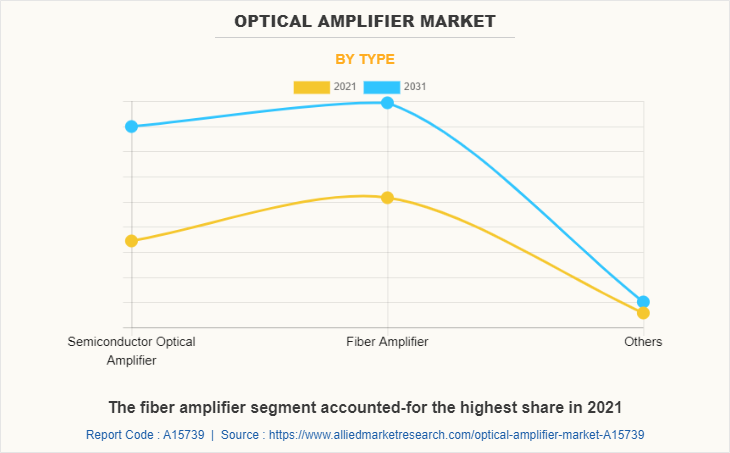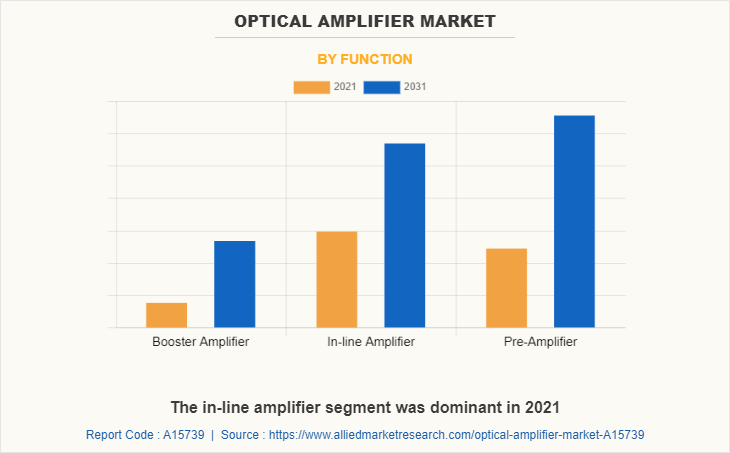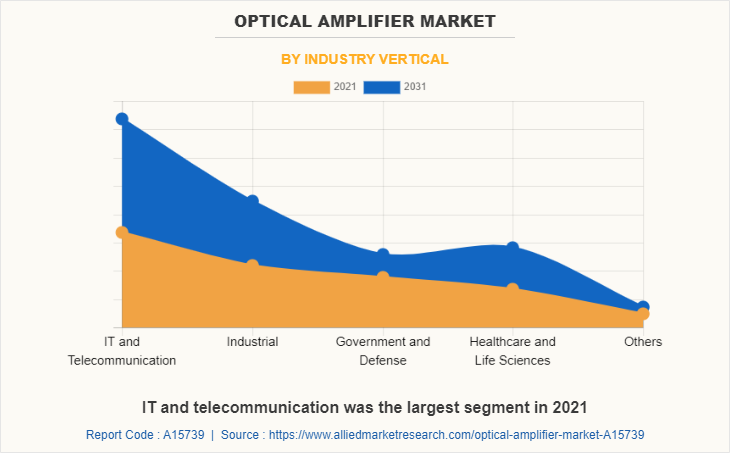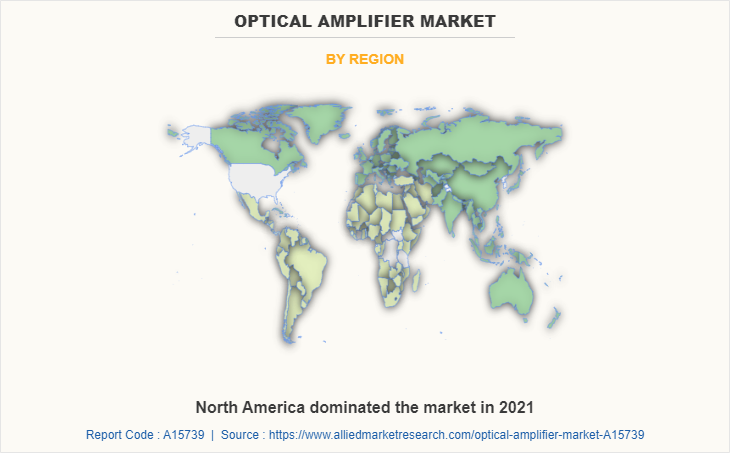Optical Amplifier Market Research, 2031
The global optical amplifier market was valued at $916.4 million in 2021, and is projected to reach $1.8 billion by 2031, growing at a CAGR of 6.9% from 2022 to 2031.
Optical amplifiers amplify light without converting it to an electrical signal and is an extremely important device that supports long-distance optical communication networks. The transmission loss of light passing through an optical fiber cable cannot be ignored when the distances are long, and hence, it becomes necessary to amplify the light using an optical amplifier.
One of the important drivers of the optical amplifier industry is the increased demand for data centers. The increase in the use of cloud services, and the growth of e-commerce, and big data analytics have led to an increase in demand for data. There is a rise in demand for data centers as these trends have resulted in an exponential increase in the amount of data that needs to be processed and stored. Data centers require high-speed and reliable communication networks to transfer copious amounts of data quickly and efficiently. Optical amplifiers play a crucial role in the communication system of data centers, as they help to boost the signal strength and stop it from becoming too noisy and enable high-speed data transmission. The increase in the deployment of smart cities and smart homes is another important driver owing to the fact that smart cities and smart homes rely heavily on optical fiber networks to transmit large amounts of data quickly and efficiently.
The deployment of smart cities involves the use of various technologies such as Internet of Things (IoT) sensors, traffic management systems, and security cameras, which all require high-speed and reliable data transmission. The increase in demand for high-speed data transfers is also equally important. The demand for high-speed data transfer in optical amplifiers is driven by the increase in the need for faster and more reliable data communication systems and boosted by the development of new technologies such as 5G which make it possible.
On the other hand, optical amplifiers are expensive to purchase and install. The cost of equipment for these devices may vary depending on the type of amplifiers being used and the specific requirement of the network. Optical amplifiers require regular maintenance to ensure that they are operating in peak conditions. Separately, the increase in the use of hyper-converged infrastructure creates opportunities for the optical amplifier market growth. Optical amplifiers play a critical role in supporting the networking component of HCI as they are used to boost the signal strength in optical fiber cables, enabling high speed and data transfer over long distances.

The optical amplifier market size is segmented into Type, Function and Industry Vertical.

On the basis of type, the optical amplifier market share is classified into semiconductor optical amplifier, fiber amplifier, and others, such as hybrid optical amplifier. The market was dominated by the fiber amplifier segment in 2021, whereas the semiconductor optical amplifier segment is expected to witness a higher growth rate during the forecast period. Fiber amplifiers primarily consist of erbium-doped fiber amplifier (EDFA) and Raman fiber amplifier (RFA). Their market is further driven by their important characteristics such as the ability of EDFAs to amplify multiple optical signals simultaneously and to be used with wavelength division multiplexing (WDM) technology.

On the basis of function, the optical amplifier market analysis is classified into booster amplifier, in-line amplifier, and pre-amplifier. The market was dominated by the in-line amplifier segment in 2021, whereas the pre-amplifier segment is expected to witness a higher growth rate during the forecast period. An in-line amplifier is primarily used for compensating splitter losses or fiber losses in an optical fiber transmission system. The important performance parameters of in-line optical amplifiers are the noise figure and saturation output power, on account of the weak incoming signals.

On the basis of industry vertical, the optical amplifier market forecast is classified into IT and telecommunications, industrial, government and defense, healthcare and life sciences, and others. The market was dominated by the IT and telecommunication segment in 2021, which is also expected to witness a higher growth rate during the forecast period. The change in habits of people and changing processes of companies are expected to drive the use of optical amplifiers in the IT and telecommunications industry. Furthermore, the industry is a hotbed of innovation, with new types of technologies and equipment released frequently. This focus on research and development is also expected to be a major driver of the optical amplifier market.

By region, the optical amplifier market outlook is analyzed across North America, Europe, Asia-Pacific, and LAMEA. The market was dominated by North America in 2021, which is also anticipated to expand at a faster rate during the forecast period. North America is among the places, so far, with the highest adoption of the Internet of Things (IoT) and Industry 4.0. These technologies enable significant amounts of data transfers, which require optical amplifiers to take place in a reliable manner. It is also one of the largest manufacturing hubs of the world, after China. In combination, this provides significant opportunities for the purchase and use of optical amplifiers.
Competitive Analysis
Competitive analysis and profiles of the major optical amplifier market players that have been provided in the report include Broadcom Inc., Coherent Corporation, Furukawa Co. Ltd., NEC Corporation, Source Photonics, APE Angewandte Physik und Elektronik GmbH, EMCOR Group Inc., IPG Photonics Corporation, Lumentum Operations LLC, and Sumitomo Electric Industries, Ltd. These key players adopt several strategies such as new product launch and development, acquisition, partnership and collaboration and business expansion to increase their market share in the global optical amplifier market during the forecast period.
Top Impacting Factors
The growth of the global optical amplifier market is driven by its usage in data centers and by the increase in the requirement for data centers. More data centers are required now due to the rise in the use of cloud services, e-commerce, and big data analytics. The deployment of smart cities and smart homes is also an important development for the optical amplifier market. The technologies on which smart cities are built, need to deploy optical amplifiers to ensure proper transmission of large amounts of data. Furthermore, the higher use of bandwidth by companies also drives the optical amplifier market opportunity. However, optical amplifiers are expensive to purchase and install. Their costs are highly affected by various scenarios and circumstances. In addition, the adoption of hyper-converged infrastructure (HCI) is expected to generate new opportunities for the optical amplifier market.
Historical Data & Information
The optical amplifier market is fairly competitive, owing to the strong presence of existing vendors. Market vendors are expected to gain a competitive advantage over their competitors because they can cater to market demands with a wide range of products. The competitive environment in this market is expected to increase as technological innovations, product extensions, and different strategies are adopted by key vendors.
Key Developments/Strategies
Broadcom Inc., Coherent Corporation, Furukawa Co. Ltd., NEC Corporation, and IPG Photonics Corporation are among the top companies which hold a prime share in the optical amplifier market. Top market players have adopted various strategies such as product launches, contracts, and others to expand their foothold in the optical amplifier market.
- In August 2022, IPG Photonics Corporation announced that it has sold its telecom transmission product lines, comprised of optical transceivers and coherent components, to Lumentum.
- In May 2022, EMCORE Corporation has acquired L3Harris Space and Navigation business. This acquisition provides an immediate contribution of additional scale in this market and expands EMCORE’s inertial navigation product portfolio and addressable market with the addition of navigation and strategic grade gyro and Inertial Measurement Unit (IMU) products.
- In July 2021, Fujitsu Optical Components Limited announced an agreement with Furukawa Electric on their co-operation towards the development of next-generation integrated devices for optical communications. In this co-operative agreement, Furukawa Electric will promote the creation of market-leading, optical device innovations through collaboration between Fujitsu Optical Components Limited which has the top share in the optical transceiver device market. This will lead the market in compound semiconductors including tunable light sources.
Key Benefits For Stakeholders
- This report provides a quantitative analysis of the market segments, current trends, estimations, and dynamics of the optical amplifier market analysis from 2021 to 2031 to identify the prevailing optical amplifier market opportunities.
- The market research is offered along with information related to key drivers, restraints, and opportunities.
- Porter's five forces analysis highlights the potency of buyers and suppliers to enable stakeholders make profit-oriented business decisions and strengthen their supplier-buyer network.
- In-depth analysis of the optical amplifier market segmentation assists to determine the prevailing market opportunities.
- Major countries in each region are mapped according to their revenue contribution to the global market.
- Market player positioning facilitates benchmarking and provides a clear understanding of the present position of the market players.
- The report includes the analysis of the regional as well as global optical amplifier market trends, key players, market segments, application areas, and market growth strategies.
Optical Amplifier Market Report Highlights
| Aspects | Details |
| Market Size By 2031 | USD 1.8 billion |
| Growth Rate | CAGR of 6.9% |
| Forecast period | 2021 - 2031 |
| Report Pages | 256 |
| By Type |
|
| By Function |
|
| By Industry Vertical |
|
| By Region |
|
| Key Market Players | Sumitomo Electric Industries, Ltd., EMCOR Group Inc., APE Angewandte Physik und Elektronik GmbH, IPG Photonics Corporation, Lumentum Operations LLC, Source Photonics Inc., NEC Corporation, Broadcom Inc., Coherent Corporation, Furukawa Co. Ltd. |
Analyst Review
Optical amplifiers have provided consistent sales in the market for a very long time and this is expected to continue during the forecast period. The demand is expected to be driven by several factors such as their requirement in data centers, new technologies such as 5G networks or hyper-converged infrastructures (HCI), their ease of availability, and the adoption of smart cities and smart homes globally.
Adoption of technology by industries, companies, and governments for all sections of supply-chain, ranging from manufacturing to transportation and IT and telecommunication, to healthcare is expected to have a positive impact on the global optical amplifier market in the coming years. For instance, Industry 4.0 now seems to be in full swing, since its start in 2011. Start-ups now receive around $3 billion in funding each year, M&A activity has doubled, and more than 50,000 research papers were written on the subject in 2021 itself.
Furthermore, this has happened on the back of powerful electrical and electronic equipment such as powerful chipsets, widespread cloud services adoption, open interfaces for edge-computing hardware, better communication standards and protocols, and highly relevant AI models. The global COVID-19 pandemic only helped further the trend toward Industry 4.0 and the progress on the Internet of Things (IoT) has also encouraged further adoption. According to a report by the National Association of Software and Services Companies (NASSCOM) and Capgemini, global investments in Industry 4.0 have increased approximately 10X in the past decade and are anticipated to reach $200+ billion by 2025.
These trends are only expected to continue in the forthcoming years, on the back of widespread competition between countries as well as companies on the technological front, as the adoption of technologies is expected to drive efficiencies, productivity, and profits. Demand for optical amplifiers is expected to be driven by these developments as the adoption of these technologies also requires the usage of optical amplifiers.
The optical amplifier market size was valued at $916.37 million in 2021, and is projected to reach $1,792.88 million by 2031, registering a CAGR of 6.9%.
Fiber amplifier was the leading type of optical amplifier in 2021.
IT and telecommunications industry was the leading industry vertical in 2021.
North America was the leading region in 2021.
The top companies in the optical amplifier market include Broadcom Inc., Coherent Corporation, Furukawa Co. Ltd., NEC Corporation, Source Photonics, APE Angewandte Physik und Elektronik GmbH, EMCOR Group Inc., IPG Photonics Corporation, Lumentum Operations LLC, and Sumitomo Electric Industries, Ltd.
Loading Table Of Content...
Loading Research Methodology...


